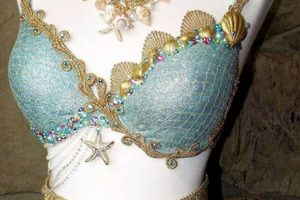Creating a personalized representation of the Star Wars character Anakin Skywalker offers a cost-effective and imaginative approach to costuming. The process involves assembling readily available materials and employing basic crafting techniques to produce an individualized outfit reminiscent of the iconic Jedi Knight. For example, a novice enthusiast might utilize repurposed fabrics and modified clothing items to construct a simplified version of Anakin’s attire.
The advantages of constructing a personalized Anakin Skywalker costume extend beyond mere economic savings. This approach fosters creativity and encourages resourcefulness, allowing individuals to tailor the outfit to their specific body type and aesthetic preferences. Historically, homemade costumes have served as a testament to individual ingenuity and dedication, allowing fans to express their passion through tangible creations.
The subsequent discussion will delve into specific components of the process, including sourcing appropriate fabrics, adapting existing clothing patterns, and employing finishing techniques to achieve a recognizable and satisfying final product. Detailed instructions and considerations for each stage of the project will be presented.
Tips for Constructing a Personalized Anakin Skywalker Costume
The following guidelines offer practical advice for those undertaking the construction of a personalized Anakin Skywalker costume. Attention to detail and a methodical approach are crucial for achieving a satisfying result.
Tip 1: Conduct Thorough Research: Before commencing any fabrication, meticulously examine various visual representations of Anakin Skywalker’s attire from different Star Wars episodes and sources. Note variations in color, texture, and detailing to inform design choices.
Tip 2: Prioritize Fabric Selection: Opt for fabrics that closely mimic the texture and drape of those depicted in the source material. Linen, cotton blends, and faux leather are viable options, depending on the specific garment being replicated. Consider fabric weight and breathability for comfort and durability.
Tip 3: Modify Existing Clothing Patterns: Rather than attempting to draft patterns from scratch, adapt existing patterns for garments such as tunics, pants, and vests. This approach simplifies the construction process and ensures a more accurate fit.
Tip 4: Incorporate Accurate Detailing: Pay close attention to the smaller details that distinguish Anakin Skywalker’s costume, such as the quilted pattern on the tabards, the specific design of the belt, and the placement of pouches. Replicating these details elevates the realism of the costume.
Tip 5: Employ Weathering Techniques: To achieve a battle-worn appearance, consider employing weathering techniques such as dry brushing with diluted paints or lightly sanding the fabric to create subtle distressing effects. This adds depth and realism to the finished costume.
Tip 6: Ensure Proper Fit and Comfort: Prioritize a comfortable and functional fit. Ensure that the costume allows for freedom of movement and does not restrict breathing or circulation. Conduct test fittings throughout the construction process to make necessary adjustments.
Tip 7: Accessorize Appropriately: A lightsaber, boots, and a Jedi belt are essential accessories for completing the Anakin Skywalker look. Select accessories that complement the overall design and maintain consistency with the source material.
Adhering to these guidelines will contribute to the creation of a convincing and personalized Anakin Skywalker costume, allowing for a more authentic and engaging experience.
The subsequent sections will address specific aspects of costume maintenance and storage to ensure the longevity of the finished product.
1. Fabric Acquisition
Fabric acquisition constitutes a foundational element in the successful execution of a personalized Anakin Skywalker costume project. The selection of appropriate textiles directly influences the visual authenticity, durability, and overall comfort of the finished garment. Incorrect fabric choices can detract from the costume’s likeness to the source material and compromise its longevity. For instance, utilizing a modern synthetic material for a Jedi tunic, instead of a natural fiber like linen or cotton, can result in an appearance that deviates significantly from the intended aesthetic. The cost and accessibility of fabrics further dictate the feasibility of the project.
The process of fabric acquisition necessitates careful consideration of various factors, including color, texture, weight, and drape. Replicating the specific appearance of Anakin Skywalker’s attire requires sourcing fabrics that closely match the on-screen depictions. Lightweight, breathable fabrics are preferable for garments worn close to the body, ensuring comfort during extended wear. The durability of the fabric is paramount for costumes intended for frequent use or display. Sourcing strategies may involve online retailers, local fabric stores, or repurposing existing materials.
In summary, effective fabric acquisition is an indispensable component of any endeavor to create a personalized Anakin Skywalker costume. This stage requires careful planning, research, and a discerning eye to ensure that the selected materials meet the project’s aesthetic and functional requirements. Overlooking this crucial aspect can result in a final product that falls short of expectations. Success here directly impacts the subsequent construction phases and overall quality of the completed costume.
2. Pattern Modification
Pattern modification is a critical process within the creation of a personalized Anakin Skywalker costume. Existing patterns, whether commercially purchased or self-drafted, rarely conform precisely to the unique design elements and specific fit requirements of the character’s attire. Adapting these patterns is therefore essential for achieving a credible and aesthetically pleasing result.
- Sizing Adjustments
Pre-existing patterns are often based on standard sizing conventions, which may not accurately reflect the wearer’s individual body measurements. Modifications to the bust, waist, shoulders, and inseam are commonly necessary to ensure a comfortable and flattering fit. Neglecting these adjustments can lead to a costume that is either too restrictive or excessively loose, diminishing the overall appearance.
- Style Alterations
Anakin Skywalker’s garments exhibit distinct stylistic features, such as the specific shape of the tunic neckline, the cut of the tabards, and the construction of the pants. These features are rarely present in standard commercial patterns. Consequently, alterations are required to introduce these stylistic elements, potentially involving redrawing seam lines, adding or removing fabric
panels, and modifying the overall silhouette of the pattern pieces. - Detail Integration
The incorporation of details such as pleats, darts, and embellishments often necessitates further pattern modifications. For example, adding pleats to the tunic sleeves might require altering the sleeve pattern to accommodate the additional fabric. Similarly, integrating specific seam lines or decorative elements could involve redrawing pattern pieces and adding new construction markings.
- Fabric Compensation
Different fabrics behave differently during construction. Stretchy fabrics require different pattern adjustments than non-stretch fabrics. Compensating for fabric drape, weight, and shrinkage is crucial for ensuring that the final garment matches the intended design and fit. Failure to account for these factors can result in unexpected distortion or ill-fitting components.
The ability to effectively modify existing patterns is a fundamental skill for anyone undertaking a personalized Anakin Skywalker costume project. This process enables the precise replication of the character’s attire, ensuring both visual accuracy and a comfortable, personalized fit. Mastering this aspect significantly enhances the overall quality and authenticity of the completed costume.
3. Accurate Detailing
In the context of “anakin costume diy,” accurate detailing represents a pivotal factor determining the overall success and believability of the finished product. Fidelity to the source material, encompassing visual elements discernible in the character’s on-screen appearances, necessitates a meticulous approach to replicating nuanced aspects of the costume.
- Tabard Quilt Pattern Replication
The quilted texture on Anakin Skywalker’s tabards is not uniform but comprises a specific diamond or square pattern. Failing to accurately replicate this pattern diminishes the visual accuracy. Commercially available quilted fabric often deviates from the correct pattern, necessitating custom quilting or the application of individual stitches to achieve the required aesthetic. The choice of stitch pattern, thread color, and stitch density directly affects the realism.
- Belt and Pouches Configuration
The belt worn by Anakin Skywalker features a distinct configuration of pouches and accessories. The type, size, and arrangement of these elements are not arbitrary; they conform to a specific design. Substituting generic pouches or altering their placement detracts from the accuracy. Sourcing or fabricating pouches that match the on-screen depictions, along with replicating the correct belt buckle and hardware, is crucial for authenticity.
- Tunic and Undershirt Layering and Texture
Anakin Skywalker’s costume incorporates multiple layers, including a tunic and undershirt, each with distinct fabric textures and colors. The interplay between these layers contributes to the overall visual depth of the costume. Neglecting to accurately reproduce the textures or correctly layer the garments results in a less convincing representation. The collar height, sleeve length, and overall fit of each layer must align with the established visual characteristics.
- Boot Style and Detailing
The boots worn by the character feature a specific style and detailing, often incorporating buckles or straps. Substituting generic boots or omitting these details undermines the overall accuracy. Sourcing boots that closely resemble the on-screen depictions, or modifying existing boots to match the required style, contributes significantly to the costume’s authenticity. The height of the boot, the type of closure, and the presence of any decorative elements are all relevant considerations.
The cumulative impact of these detailed elements determines the fidelity of the “anakin costume diy” project to the original source material. While budgetary constraints or skill limitations may necessitate compromises, prioritizing the accurate replication of key visual details enhances the believability of the costume and contributes to a more immersive experience.
4. Weathering Effects
Weathering effects constitute a crucial element in achieving visual authenticity in a personalized Anakin Skywalker costume. These techniques artificially simulate the wear and tear inherent in the character’s occupation as a Jedi Knight engaged in frequent combat and travel. The absence of appropriate weathering can render a costume appearing too pristine and detract from its believability within the Star Wars universe.
- Dry Brushing Application
Dry brushing involves applying small amounts of lightly colored paint with a dry brush to create highlights on the fabric. This technique effectively simulates dust accumulation in creases and along edges, enhancing the texture and depth of the costume. For “anakin costume diy,” examples include using tan or grey paint on the tunic and tabards to mimic exposure to the arid environments often depicted in the films. Inappropriate color choices or excessive application diminishes the realistic effect.
- Sanding and Abrasion Techniques
Lightly sanding certain areas of the fabric, particularly along seams and edges, replicates the effect of abrasion and wear. This technique softens the sharp edges of newly constructed garments and introduces subtle fraying, contributing to a more lived-in appearance. For “anakin costume diy,” this can be applied to the edges of the tabards or the knees of the pants to simulate the effects of movement and contact. Over-abrasion results in damage and an unnatural look.
- Stain Application and Blending
Strategic application of diluted paints or dyes simulates stains from dirt, sweat, or other environmental factors. Careful blending is essential to avoid harsh lines or unnatural blotches. For “anakin costume diy,” this might involve applying diluted brown or black paint to the lower portions of the tunic and pants to represent dirt accumulation from ground contact. Uneven application or excessive staining can detract from the realism.
- Fabric Dyeing and Fading Techniques
Subtle alterations to the fabric’s original color through dyeing or fading techniques introduce variations that mimic the effects of sun exposure and repeated washing. This creates a more nuanced and realistic appearance. For “anakin costume diy,” this could involve lightly bleaching the tunic or tabards to simulate sun fading or using diluted dyes to create subtle variations in color across different areas of the costume. Over-bleaching or uneven dyeing can result in an unrealistic or damaged appearance.
Effective implementation of weathering effects transforms a newly constructed “anakin costume diy” project into a visually compelling representation of a character with a history. These techniques, when applied judiciously and with attention to detail, significantly enhance the costume’s authenticity and believability.
5. Accessory Selection
In “anakin costume diy,” accessory
selection functions as a pivotal determinant of overall visual impact and character portrayal accuracy. The accessories serve as visual cues that provide context and reinforce the chosen representation. Incorrect or poorly chosen accessories can detract from the effectiveness of an otherwise meticulously crafted costume. For instance, a generic toy lightsaber, in lieu of a replica lightsaber with accurate dimensions and details, immediately diminishes the authenticity of the “anakin costume diy” project. Similarly, a belt lacking the correct pouches and fastening mechanisms compromises the character’s recognizable silhouette. The accessories, therefore, act as finishing touches that solidify the chosen interpretation.
The connection between “accessory selection” and “anakin costume diy” extends beyond mere aesthetics. Practical considerations, such as the functionality and durability of accessories, also influence the overall success. A poorly constructed belt, for example, may fail to securely hold the various pouches and accessories, affecting the wearer’s mobility and comfort. The selection process necessitates careful evaluation of materials, construction techniques, and overall design. Replica lightsabers, often requiring substantial investment, exemplify this consideration. The cost, weight, and light/sound effects of such replicas are key factors in the selection process. The choice of boots also requires scrutiny; they must be comfortable for extended wear, visually consistent with the character’s footwear, and durable enough to withstand various environmental conditions.
In summary, the effective execution of “anakin costume diy” relies heavily on the thoughtful and discerning selection of accessories. These elements transcend mere ornamentation, serving as critical components that contribute to the costume’s visual integrity, functional viability, and overall authenticity. Challenges in this area may include budget constraints, sourcing rare or specialized items, and ensuring a cohesive aesthetic across all accessories. Nevertheless, prioritizing accurate and well-chosen accessories significantly enhances the impact and believability of the completed “anakin costume diy” project.
6. Durability Emphasis
Durability Emphasis, within the context of “anakin costume diy,” signifies the prioritization of constructing a costume that withstands repeated use, handling, and environmental exposure. This focus extends beyond mere aesthetic considerations, addressing the practical requirements for a costume intended for frequent wear at conventions, performances, or other events. The inherent fragility of certain fabrics and construction techniques necessitates a conscious effort to reinforce vulnerable areas and employ durable materials.
- Fabric Selection for Longevity
The choice of fabrics significantly impacts the costume’s long-term durability. Opting for high-quality, tightly woven materials, such as robust cotton blends or reinforced synthetics, provides greater resistance to tearing and abrasion. For example, using a heavy-duty canvas for the tabards, rather than a lightweight linen, enhances their ability to withstand stress and maintain their shape. This careful selection reduces the likelihood of damage from routine wear and tear.
- Reinforced Seam Construction
Seams represent potential points of failure in any garment. Reinforcing seams through techniques such as double stitching, serging, or applying seam binding increases their strength and prevents unraveling. In “anakin costume diy,” reinforcing stress points, such as the shoulder seams of the tunic or the crotch of the pants, is particularly crucial. These reinforcements prolong the costume’s lifespan and prevent costly repairs.
- Hardware and Fastening Security
Accessories such as belts, buckles, and closures are integral components of the Anakin Skywalker costume. Selecting durable hardware made from metal or high-impact plastic, and ensuring secure fastening methods, is essential. For example, replacing plastic buckles with metal alternatives and reinforcing the attachment points of pouches to the belt enhances the costume’s reliability. Failure to address these details can result in broken accessories and a compromised appearance.
- Protective Finishes and Treatments
Applying protective finishes or treatments to the fabric can enhance its resistance to stains, water damage, and UV degradation. Treatments such as fabric protectants or UV inhibitors extend the costume’s lifespan and maintain its appearance over time. For “anakin costume diy,” applying a water-repellent finish to the outer layers protects against accidental spills and environmental moisture, while UV inhibitors prevent color fading from prolonged exposure to sunlight.
Integrating these facets of Durability Emphasis into the “anakin costume diy” project yields a costume that not only accurately portrays the character but also withstands the rigors of repeated use and handling. This proactive approach minimizes the need for frequent repairs or replacements, representing a cost-effective and sustainable approach to costuming. The long-term value of a durable costume surpasses the initial investment of time and resources in implementing these protective measures.
Frequently Asked Questions
The following section addresses common inquiries and concerns regarding the creation of a personalized Anakin Skywalker costume. These questions aim to provide clarity and guidance for individuals undertaking this project.
Question 1: What is the recommended budget for constructing a reasonably accurate Anakin Skywalker costume?
The financial investment varies significantly based on material quality, accessory selection, and the complexity of construction techniques employed. A basic costume, utilizing repurposed fabrics and readily available accessories, may cost between $100 and $300. A more elaborate costume, incorporating high-quality fabrics, custom-made accessories, and detailed weathering effects, can easily exceed $500 or more.
Question 2: What are the most challenging aspects of creating this type of costume?
Common challenges include accurately replicating the fabric textures and colors, adapting existing patterns to match the specific design elements, and achieving a comfortable and functional fit. Fabric acquisition, particularly sourcing accurate matches for the tunic and tabards, often presents a significant hurdle. Detailed accessories, such as the belt and lightsaber, also require considerable effort to replicate accurately.
Question 3: Where can one find reliable patterns or tutorials for constructing an Anakin Skywalker costume?
Numerous online resources provide patterns, tutorials, and guidance for constructing Star Wars costumes. Websites dedicated to costuming, fan forums, and video-sharing platforms offer a wealth of information. It is crucial to evaluate the credibility and accuracy of these resources before relying on them for construction details. Reputable pattern companies may also offer patterns that can be adapted for this purpose.
Question 4: What type of lightsaber prop is most appropriate for completing the costume?
The choice of lightsaber depends on budgetary considerations and desired level of realism. Inexpensive plastic toy lightsabers are readily available but lack the visual fidelity and durability of more expensive options. Replica lightsabers, often constructed from metal and incorporating light and sound effects,
provide a more immersive and authentic experience. These replicas can range in price from several hundred to several thousand dollars.
Question 5: How can one achieve realistic weathering effects on the costume without damaging the fabric?
Weathering effects should be applied cautiously and with appropriate techniques to avoid damaging the fabric. Dry brushing with diluted paints, sanding with fine-grit sandpaper, and strategic application of diluted dyes are common methods. Testing these techniques on scrap fabric before applying them to the costume is essential. Over-weathering can detract from the overall appearance and compromise the fabric’s integrity.
Question 6: What are the recommended methods for cleaning and storing an Anakin Skywalker costume to maintain its condition?
Cleaning methods vary depending on the fabric composition and construction techniques employed. Hand washing with mild detergent is generally recommended for delicate fabrics. Dry cleaning may be necessary for certain materials. Proper storage involves hanging the costume in a cool, dry place, away from direct sunlight. Using a garment bag protects the costume from dust and damage.
These FAQs provide a preliminary understanding of the considerations involved in constructing a personalized Anakin Skywalker costume. Careful planning, attention to detail, and a commitment to quality craftsmanship are essential for achieving a successful outcome.
The subsequent section will delve into specific troubleshooting tips for common challenges encountered during the costume construction process.
Conclusion
This exposition has detailed the multifaceted nature of “anakin costume diy,” underscoring the critical elements that contribute to a successful outcome. Fabric acquisition, pattern modification, accurate detailing, weathering effects, accessory selection, and durability emphasis each play a significant role in realizing a convincing and enduring representation of the character. The challenges inherent in this endeavor necessitate a methodical approach, informed by research and a commitment to quality craftsmanship.
The pursuit of “anakin costume diy” transcends mere replication; it embodies a dedication to the source material and a celebration of individual creativity. The diligent application of the principles outlined herein will enable enthusiasts to craft costumes that not only capture the visual essence of Anakin Skywalker but also withstand the test of time, serving as lasting testaments to their passion and skill. Future advancements in materials and techniques may further refine the process, but the fundamental principles of careful planning and meticulous execution will remain paramount.







